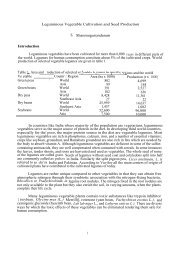Management of the Diamondback Moth and Other Crucifer Insect ...
Management of the Diamondback Moth and Other Crucifer Insect ...
Management of the Diamondback Moth and Other Crucifer Insect ...
Create successful ePaper yourself
Turn your PDF publications into a flip-book with our unique Google optimized e-Paper software.
0.84, 1.40 <strong>and</strong> 1.69 mm, respectively (Table 2). Theneonate larvae were gregarious on <strong>the</strong> abaxial surface<strong>and</strong>, for up to 5 days after hatching, fed by scraping <strong>the</strong>leaf resulting in a papery appearance. The medium sizelarvae fed on <strong>the</strong> underside <strong>of</strong> <strong>the</strong> leaf without eatingthrough <strong>the</strong> uppermost leaf layer <strong>and</strong> created windowlikedamage. In <strong>the</strong> later stage, <strong>the</strong> larvae causeddefoliation, entered into <strong>the</strong> head <strong>of</strong> <strong>the</strong> cauliflower <strong>and</strong>made tunnels, which were covered by fine silken webswith rotting <strong>of</strong> crops.Table 1. Duration <strong>of</strong> different stages in <strong>the</strong> life cycle <strong>of</strong> Crocidolomia binotalis on CauliflowerS. No. Particulars/StageDuration (Days)Minimum Maximum Mean ± SEM*1. Egg period 2.0 4.0 3.0 ± 0.062. Larval periodI instar 2.00 3.00 2.50 ± 0.040II instar 2.00 3.00 2.50 ± 0.043III instar 1.50 2.50 2.00 ± 0.025IV instar 1.50 2.50 2.00 ± 0.020V instar 1.50 2.50 2.00 ± 0.023Total larval period 8.50 13.50 11.00 ± 0.0473. Pre-pupal period 1.00 2.00 1.50 ± 0.0234. Pupal period 6.00 8.00 7.00 ± 0.1285. Pre-oviposition period 1.00 2.00 1.50 ± 0.0226. Oviposition period 5.00 7.00 6.00 ± 0.1457. Adult longevityMale 2.00 3.00 2.50 ± 0.237Female 1.00 2.00 1.50 ± 0.2048. Total duration <strong>of</strong> life cycle (Egg to adult longevity)Male 26.00 40.00 32.50 ± 0.962Female 25.00 39.00 31.50 ± 0.9469. Adult emergence (%) 62.27 72.45 67.36 ± 1.462Male 27.98 32.55 30.26 ± 0.653Female 34.30 39.90 37.10 ± 0.801Sex ratio 1 : 1.23PupaWhen <strong>the</strong> larvae reached full growth, <strong>the</strong>y burrowed into<strong>the</strong> soil near <strong>the</strong> base <strong>of</strong> <strong>the</strong> plant <strong>and</strong> pupated. Thefreshly formed pupae were yellowish-brown, which laterbecame dark brown in colour. The average size <strong>of</strong> <strong>the</strong>pupa was 10.0 mm in length with 3.0 mm width in males<strong>and</strong> 12.0 mm in length with 4.0 mm width in females.The pupal period ranged from 6 to 8 days.AdultThe female moths emerged about one day before <strong>the</strong>males. Adults have black thoraxes <strong>and</strong> reddish brownabdomens. Females bear a curved ovipositor <strong>and</strong> weregenerally larger than males. During <strong>the</strong> day <strong>the</strong>y hideunder <strong>the</strong> cauliflower leaves <strong>and</strong> when disturbed, <strong>the</strong>ywere able to fly for short distances. In both males <strong>and</strong>females, <strong>the</strong>re were considerable variations in delineation<strong>of</strong> markings on <strong>the</strong> cream background <strong>of</strong> <strong>the</strong> forewings.Males have greater delineation <strong>and</strong> were easilyrecognized by a tuft <strong>of</strong> dark hairs at <strong>the</strong> anterior margin<strong>of</strong> <strong>the</strong> forewings, which <strong>the</strong> females lacked (Figure 1).The adult wing span was 21.5 <strong>and</strong> 19.5 mm in males <strong>and</strong>females, respectively. Males have larger bodies (12.5mm) than females (10.0 mm). But, visually, femaleshave larger abdomens than males. On an average, male<strong>and</strong> female moths survived for 10.0 <strong>and</strong> 9.0 days. Thetotal lifecycle <strong>of</strong> males <strong>and</strong> females lasted for 32.5 <strong>and</strong>31.5 days. The mean pre-oviposition, oviposition <strong>and</strong>adult longevity after oviposition for a female were 1.5,6.0 <strong>and</strong> 1.5 days, respectively.The 6th International Workshop on <strong>Management</strong> <strong>of</strong> <strong>the</strong> <strong>Diamondback</strong> <strong>Moth</strong> <strong>and</strong> O<strong>the</strong>r <strong>Crucifer</strong> <strong>Insect</strong> Pests 33
















